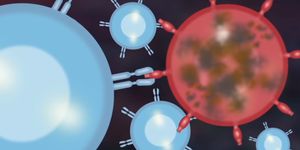RNA Structure Informs RNA Function
Proteins carry out many of an organism's critical functions, and they are coded for by genes. To make a protein from a gene, a cell first needs a copy of the gene in the form of a molecule called RNA. After a gene is transcribed into RNA, the RNA can be modified in many ways before the protein is translated from it, and those modifications impact the kind of protein that's made. RNA molecules may also be non-coding, and some can perform regulatory functions.
Researchers have been learning more about how modifications in the shape of an RNA molecule change its function. Recent work has used HIV as a model to show that the structure of an RNA molecule can affect what it does. The findings have been reported in Nature.
One modification that the cell makes to RNA is to splice out the parts it doesn't want or that don't code for protein.
"RNA splicing can influence how it encodes proteins," said Walter and Eliza Hall Institute researcher Dr. Vincent Corbin. "There are many examples of how altered RNA splicing influences how a cell functions - and in some cases, changes in RNA splicing have been associated with cancer or neurodegenerative diseases."
RNA molecules have a three-dimensional structure. This work used bioinformatics tools to look at different structures of RNA, instead of analyzing an average structure that represents several forms.
"The big question in RNA biology has been whether RNA molecules have a single, constant structure, or whether they can shift between different structures - and what this means for the function of a particular RNA molecule," said Corbin, who led the project's bioinformatics research.
"Our collaborators, led by Professor Silvi Rouskin, developed a technique for deciphering the structure of RNA molecules. We wanted to understand whether what we were detecting was a single structure of RNA, or an 'average' structure that blurs multiple different structures together," explained Corbin. "It's a bit like seeing red and yellow stripes, or blurring them together and thinking you can see orange."
The HIV genome is made of RNA. The researchers were able to use an algorithm to measure the levels of different structures of HIV's RNA genome in a tube. Then they assessed the impact of these various structures, and found they were affecting splice sites. "Using the HIV genome as a model system, we looked at whether RNA structure influences how HIV's RNA is spliced. We discovered that RNA structure was a critical determinant of RNA splicing in HIV, and influenced which viral proteins were produced," Corbin said.
Since RNA splicing can change a protein's function, this work indicates that the structure of RNA can help control its ultimate function, which opens up a new avenue in our understanding of how the biology of a cell is regulated.
Sources: AAAS/Eurekalert! via Walter and Eliza Hall Institute, Nature








